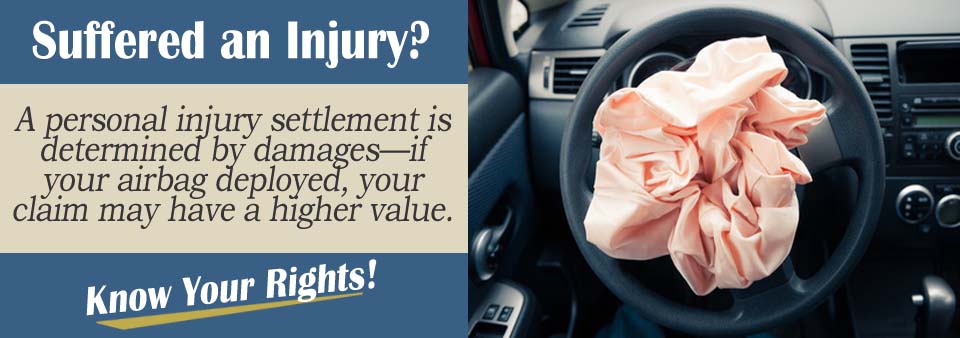Cars come equipped with life-saving devices otherwise known as airbags to prevent serious injury in the event of a frontal or side impact. However, not only do these devices save your life they also affect how serious your accident is viewed in the eyes of the insurance company.
We posed this question to attorney Alaina Sullivan, and she had this to say:
When Does It Happen?
Per the Insurance Institute for Highway Safety, a front airbag will normally deploy when the crash is roughly the equivalent of a car impacting a wall at 10 to 12 mph for unbelted occupants but over 16 mph for belted occupants.
Airbag Deployment During an Accident
Your airbag deploying in the event of a car accident can very well impact your settlement. Airbags tend to only be deployed in moderate to severe crashes.
In fact, according to the U.S. Department of Transportation, frontal and side-impact air bags are designed to deploy specifically during moderate and severe crashes. The worse the crash, the higher the settlement the insurance company is likely to pay.
Will My Claim Be Worth More?
Insurance companies utilize claims software when calculating what your personal injury claim is worth. One of the questions while using this software is “was your airbag deployed?”
If you answer yes to this question, your claim is likely to be given a higher value.
Since airbags are only deployed during moderate to severe crashes, the value of your claim is worth more than if your airbags were not deployed.
That is due to the fact that airbags are deployed in the more serious of accidents. If you were in a car accident and your airbags were deployed, the higher your claim could be.
If you are filing a claim with your insurance company, the insurance companies usually give more damages related to pain and suffering in accidents that are deemed moderate to severe. If you were in a car accident and the airbags were deployed, that would fall into that threshold and you could receive more for damages related to pain and suffering.
If My Airbags Deployed in a Car Accident is my Car Totaled?
If your airbags deployed in a car accident, it doesn't necessarily mean your car is totaled. There are a few factors that determine if the car is worth repairing or not.
The software used considers the price of replacing an airbag. An airbag replacement is generally in the $1,000 range per airbag. Depending on the value of the car, airbags deploying could be the difference between the car being considered totaled or worth repairing.
If a car has a "low cash value" it will be considered a total loss if the airbags deploy in the accident. For example, if an older car has a deployed airbag, along with body damage which caused the airbag to deploy, it's more likely that the vehicle is going to be deemed totaled. The cost to fix it isn't worth the money.
Air Bag Deployment in Rollover Accidents
Airbags are not really designed for rollover accidents. If your car flips following impact, your airbag may or may not deploy because the impact can be a bit more complicated and will involve a multitude of impacts.
Because of this, your airbag needs to remain inflated for a longer period of time to protect you. If your airbag was deployed and you were involved in a rollover accident, your injuries can be much more serious and, as a result, can be higher in terms of settlement or damages claims.

Airbags and Soft Tissue Cases
When the crash victim’s injuries are hidden and more subjective, such as the case with soft tissue injuries, airbag deployment can help prove these claims even more. Soft tissue injuries, commonly referred to as “whiplash” include neck, back or shoulder pain.
These injuries are not always visible by normal medical procedures, and the fact that your airbag deployed gives claims adjusters the assumption that a greater chance of injury existed, including soft tissue injury.
Airbag Deployment While Not Wearing a Seat Belt
Keep in mind that airbags are not supposed to be the only thing that saves your life in a car accident. These devices are meant to work alongside seat belts to protect you in a car accident.
If you were not wearing your seatbelt during your accident, insurance companies are likely to reduce your injury claim. If you want to prevent this from happening, your only recourse is to demonstrate that wearing a seat belt would not have prevented further injury.
This may be an extremely difficult argument to prove in many circumstances.
Airbags Causing Injury
Nothing is perfect. Airbags are meant to protect you from injury in the event of an accident, but sometimes the airbag can cause more injury when deployed. When deployed, the airbags come out with forceful and explosive energy, and many victims have suffered broken noses, bruises or even fatalities as a result.
If the accident caused the airbag to deploy and because of this deployment, you are injured, and the insurance company or court finds that the airbag was not faulty and did exactly what it was supposed to do, the at-fault driver could be liable for these injuries.
Contact an Attorney Today
If you've been in an accident that was severe enough to cause your airbags to deploy, you may be considering taking the legal steps necessary to be compensated for the damage to your vehicle, your medical bills, and possibly even compensation for the physical and emotional pain that your accident had put you through.
If that's the case, you may want to have a lawyer representing you throughout the claims process. They can help you establish that the other driver was at fault, gather witnesses, and negotiate with the insurance companies.
This can help you be sufficiently compensated for your accident.
